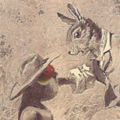HAL 9000 (nonfiction): Difference between revisions
| Line 22: | Line 22: | ||
== Fiction cross-reference == | == Fiction cross-reference == | ||
<gallery mode="traditional"> | |||
File:Brer_Rabbit_and_Tar_Baby_9000_small.png|[[Tar-Baby 9000]] uploads [[Turpentine delight]] into Brer Rabbit. | |||
</gallery> | |||
* [[Tar-Baby 9000]] | * [[Tar-Baby 9000]] | ||
Revision as of 08:22, 6 June 2016

HAL 9000 (or simply HAL) is a fictional character in Arthur C. Clarke's Space Odyssey series
The name HAL derives from "Heuristically programmed ALgorithmic" (computer). See algorithm.
HAL is a cultural icon with a personality of his own, who represents the promise and peril of technology generally and artificial intelligence specifically.
Description
First appearing in 2001: A Space Odyssey, HAL is a sentient computer (or artificial general intelligence) that controls the systems of the Discovery One spacecraft and interacts with the ship's astronaut crew.
HAL's exterior physical form is not depicted, though it is visually represented as a red television camera eye located on equipment panels throughout the ship, and its interior in the scene where his advanced memory modules are disconnected.
HAL 9000 is voiced by Douglas Rain in the two film adaptations of the Space Odyssey series and a short film voiced by Andrew Stanton.
HAL speaks in a soft, calm voice and a conversational manner, in contrast to the crewmen, David Bowman and Frank Poole, who speak tersely and with little inflection.
In addition to maintaining the Discovery One spacecraft systems during the interplanetary mission to Jupiter (or Saturn in the original novel, published shortly after the release of the film), HAL is capable of speech, speech recognition, facial recognition, natural language processing, lip reading, art appreciation, interpreting emotional behaviors, automated reasoning, and playing chess.
Nonfiction cross-reference
Fiction cross-reference
Tar-Baby 9000 uploads Turpentine delight into Brer Rabbit.
